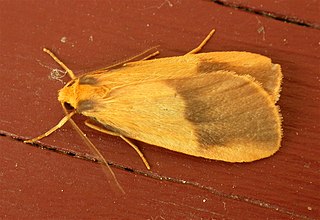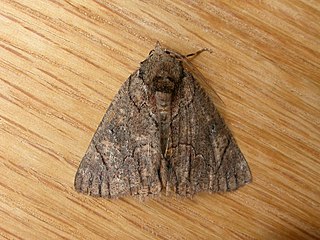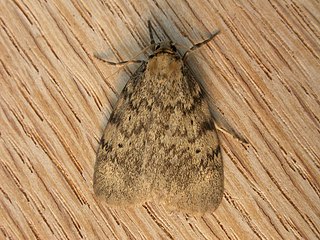Hestiarcha is a monotypic moth genus in the subfamily Arctiinae. Its single species, Hestiarcha pyrrhopa, is found in Australia, where it has been recorded from South Australia. The genus and species were first described by Edward Meyrick in 1886.
Phaeophlebosia is a monotypic moth genus in the subfamily Arctiinae erected by George Hampson in 1900. Its single species, Phaeophlebosia furcifera, the forked footman, was first described by Francis Walker in 1854. It is found in Australia, where it has been recorded from New South Wales, Victoria, Tasmania and South Australia.

Threnosia heminephes, the halved footman, is a moth of the subfamily Arctiinae first described by Edward Meyrick in 1886. It is found in Australia, where it has been recorded from the Australian Capital Territory, New South Wales and Victoria.
Stenarcha is a monotypic moth genus in the subfamily Arctiinae erected by George Hampson in 1900. Its single species, Stenarcha stenopa, was first described by Edward Meyrick in 1886. It is found in the southern part of the Australian state of Western Australia.

Heliomystis is a monotypic moth genus in the family Geometridae. Its only species, Heliomystis electrica, the electric moth, is found in the southern half of Australia. Both the genus and species were first described by Edward Meyrick in 1888.

Paradetis is a monotypic moth genus in the family Geometridae. Its only species, Paradetis porphyrias, is endemic to New Zealand. The genus and species were first described by Edward Meyrick, the genus in 1885 and the species in 1883.

Hectobrocha adoxa, the unadorned footman, is a species of moth of the subfamily Arctiinae first described by Edward Meyrick in 1886. It is known from the Australian states of New South Wales and Victoria.

Anestia ombrophanes, the clouded footman, is a moth of the subfamily Arctiinae. The species was first described by Edward Meyrick in 1886. It is known from the Australian Capital Territory, New South Wales, Queensland, Western Australia, Victoria and South Australia.
Hesychopa chionora, the white footman, is a moth of the subfamily Arctiinae. It was described by Edward Meyrick in 1886. It is found in the Australian states of Victoria, Queensland and New South Wales.
Castulo plagiata, the yellow-banded footman, is a moth of the subfamily Arctiinae. The species was first described by Francis Walker in 1854. It is found in the Australian states of New South Wales, Victoria and Tasmania.
Ceryx sphenodes is a moth of the subfamily Arctiinae. It was described by Edward Meyrick in 1886. It is found in New Guinea and Queensland, Australia.
Damias procrena, the procrena footman, is a moth of the family Erebidae. The species was first described by Edward Meyrick in 1886. It is found in the Australian states of Victoria and Tasmania.
Halone ophiodes, the cryptic halone, is a moth of the subfamily Arctiinae. It was described by Edward Meyrick in 1886. It is found in Australia.
Hectobrocha pentacyma, the five-banded footman, is a moth of the subfamily Arctiinae. It was described by Edward Meyrick in 1886. It is found in the Australian states of Queensland, New South Wales and Victoria.
Philenora omophanes, the delicate philenora, is a moth in the subfamily Arctiinae. It was described by Edward Meyrick in 1886. It is found in the Australian states of New South Wales and Victoria.
Scaptesyle dichotoma, the reticulated footman, is a moth in the subfamily Arctiinae. It was described by Edward Meyrick in 1886. It is found in Australia, where it has been recorded from Queensland, New South Wales, and Victoria.
Thallarcha chrysochoa, the golden footman, is a moth in the subfamily Arctiinae. It was described by Edward Meyrick in 1886. It is found in Australia, where it has been recorded from the Australian Capital Territory, New South Wales and Victoria.
Thallarcha phalarota, the adorned footman, is a moth in the subfamily Arctiinae. It was described by Edward Meyrick in 1886. It is found in Australia, where it has been recorded from the Australian Capital Territory, New South Wales, Queensland and Victoria.
Scoliacma pactolias is a moth in the family Erebidae. It was described by Edward Meyrick in 1886. It is found in Australia, where it has been recorded from the Australian Capital Territory, New South Wales, Queensland, South Australia, Tasmania and Victoria.

Titanomis is a genus of moths containing a single species Titanomis sisyrota, also known as the frosted phoenix. Taxonomists have difficulty placing this moth within an existing superfamily. The species is currently regarded as endemic to New Zealand. Only ten specimens have ever been found and none since 1959; it is classified as "Data Deficient" by the Department of Conservation.





